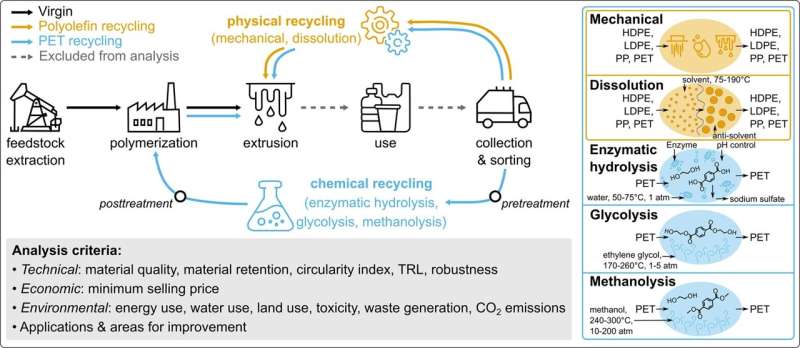This article has been reviewed according to Science X's editorial process and policies. Editors have highlighted the following attributes while ensuring the content's credibility:
fact-checked
trusted source
proofread
A systematic framework to compare performance of plastics recycling approaches

With only a small percentage of plastics recycled, determining the best way to recycle and reuse these materials may enable higher adoption of plastics recycling and reduce plastic waste pollution. Researchers at the U.S. Department of Energy's (DOE's) National Renewable Energy Laboratory (NREL) examined the benefits and trade-offs of current and emerging technologies for recycling certain types of plastics to determine the most appropriate options.
The researchers provided a comparison of various technologies for closed-loop recycling, which allow for the reuse of plastic through mechanical or chemical processing, eliminating the need for fossil-fuel-derived virgin materials. They considered technical metrics such as material quality and retention, as well as environmental metrics including energy use and greenhouse gas emissions.
"We know cost is one of the primary—if not the primary—drivers for recycling for companies wanting to invest in it," said Taylor Uekert, lead author of "Technical, economic, and environmental comparison of closed-loop recycling technologies for common plastics," which appears in the journal ACS Sustainable Chemistry & Engineering. "But I think it's just so important to remember that there are other things that are equally important for our life on this planet, and we need to be considering those environmental impacts as well."
Her co-authors, all from NREL, are Avantika Singh, Jason DesVeaux, Tapajyoti Ghosh, Arpit Bhatt, Geetanjali Yadav, Shaik Afzal, Julien Walzberg, Katrina Knauer, Scott Nicholson, Gregg Beckham, and Alberta Carpenter.
The article outlines how effectively closed-loop recycling technologies would work on polyethylene terephthalate (PET) and three types of polyolefins: high-density polyethylene (HDPE), low-density polyethylene (LDPE), and polypropylene (PP). These plastics have many uses. PET, for instance, is used to make bottles, trays, and carpets. HDPE is found in milk jugs, bags, containers, and toys. LDPE is commonly used to manufacture squeezable bottles, lids, and bags. PP, meanwhile, is used to make yogurt tubs, hangers, and straws.
The recycling rates of these polymers varied in the United States during 2019, from 2% for LDPE to 15% for PET bottles and containers.
"PET is like your common single-use water bottle," Uekert said. "You might recycle that. But most likely it's not going to come out the other end as a bottle. It's going to come out as a plastic tray for putting food on or it might be converted to plastic fibers that could be used for clothing. It's going back into the same type of plastic, but not necessarily the exact same type of plastic product."
Two closed-loop recycling methods are available for HDPE, LDPE, and PP plastics: mechanical, in which the plastic is ground up, melted, and made into something new; and solvent-based dissolution, which removes impurities so that the plastic is of suitable quality for reuse. Those same processes can be used on PET in addition to three chemical recycling technologies: enzymatic hydrolysis, glycolysis, and methanolysis.
More than 400 million metric tons of plastic waste is generated globally each year. Current recycling strategies can capture a fraction of these plastics, but there is a lack of consistent data on the capabilities and impacts of these processes. The NREL study quantitatively characterized the performance of plastic recycling technologies—including factors that are usually only discussed qualitatively, like contamination tolerance—and established a methodology for comparing new recycling processes as they emerge.
"It's not just that you can recycle plastic," Uekert said. "It's how effectively can you recycle that plastic?"
Although mechanical recycling outperforms all other technologies as well as virgin plastic production across economic and environmental metrics, the process yields lower quality plastic. Increasing the quality and quantity of plastics to be recycled through better sorting and pretreatment could improve the viability of mechanical recycling, the researchers said.
"To really enable a circular system where we keep as much material in the economy as possible, that's when we really need to improve our [material] retention through things like better sorting and better yields of your recycling processes," Uekert said.
"If you have a process that only has a 75% yield, you're going to end up needing slightly more electricity, slightly more chemicals, to recycle one kilogram of plastic than you would if you had something like a 90% or higher yield. That means your overall environmental impacts, your overall cost, is going to decrease as you increase your material retention."
The researchers pointed out recycling should be treated as a decarbonization opportunity, with the technologies using electricity that could be generated from renewable sources.
More information: Taylor Uekert et al, Technical, Economic, and Environmental Comparison of Closed-Loop Recycling Technologies for Common Plastics, ACS Sustainable Chemistry & Engineering (2023). DOI: 10.1021/acssuschemeng.2c05497
Provided by National Renewable Energy Laboratory



















